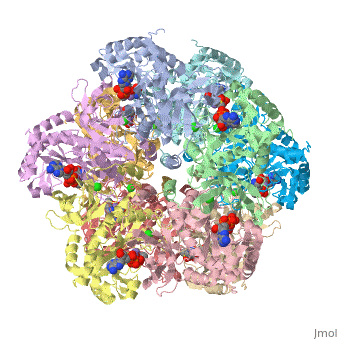User:Wayne Chang
From Proteopedia
(→Script Exercises) |
(→Script Exercises) |
||
| Line 13: | Line 13: | ||
== Script Exercises == | == Script Exercises == | ||
| - | <applet load='2qc8' size='300' frame='true' align='right | + | <applet load='2qc8' size='300' frame='true' align='right' /> |
Revision as of 22:09, 15 November 2008
Contents |
Assignment 12: IVC: Ammonium Binding Site
Mapping the Ammonium binding site and explaining how it contributes to catalysis.
Chang, Wayne and Kaushal, Pankaj.
University of Maryland, Baltimore County (UMBC).
Script Exercises
|
Exercise shows a backbone trace of Glutamate Synthase which allows the ligands inside ADP, P3S, Cl- and Mn2+ to be seen.
()
Isolates chain A of Glutamate Synthase and labels the ligands for easy identification.
()
Wire Structure of Active Site residues of chain A using information obtained from PDBsum entry for Glutamate Synthase.
()
Still picture of salt bridge between residue 63 of chain F and residue 319 of chain G. Bridge length is also provided in Angstroms.
()
Outline
-- Work in Progress --
Glutamine synthetase (GS) catalyzes the ATP dependent condensation of glutamate and ammonia, producing, glutamine, ADP, and an inorganic phosphate group.
Glutamate + ATP + NH3 → Glutamine + ADP + phosphate
Ammonium ion is thought to bind to GS at the monovalent cation binding site for Tl(+) and Cs(+) ions.
References
1. Liaw, S-H, et.al.,Discovery of the ammonium substrate site on glutamine synthetase, a third cation binding site Protein Sci. 1995 4: 2358-2365[1]
2. Liaw SH, Eisenberg D. Structural model for the reaction mechanism of glutamine synthetase, based on five crystal structures of enzyme-substrate complexes. Biochemistry. 1994 Jan 25;33(3):675-81. [2]

